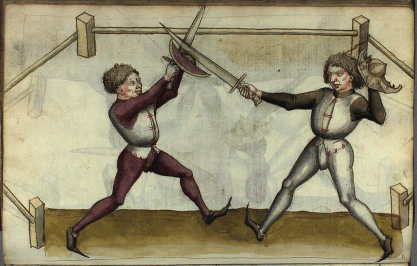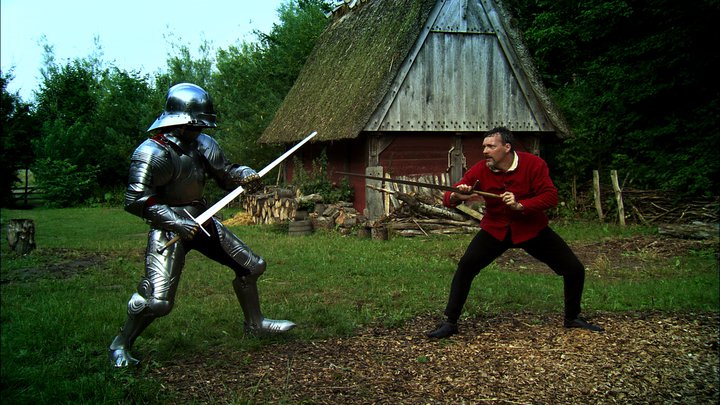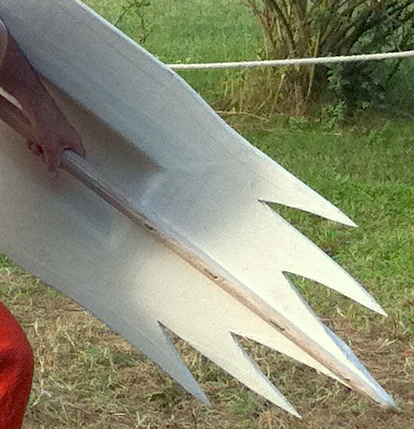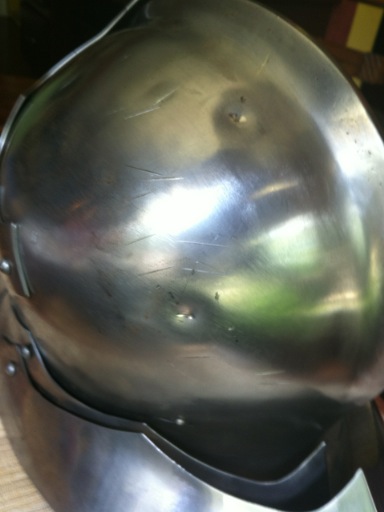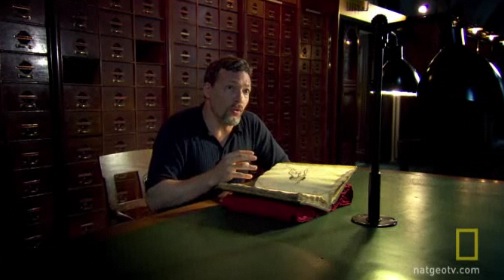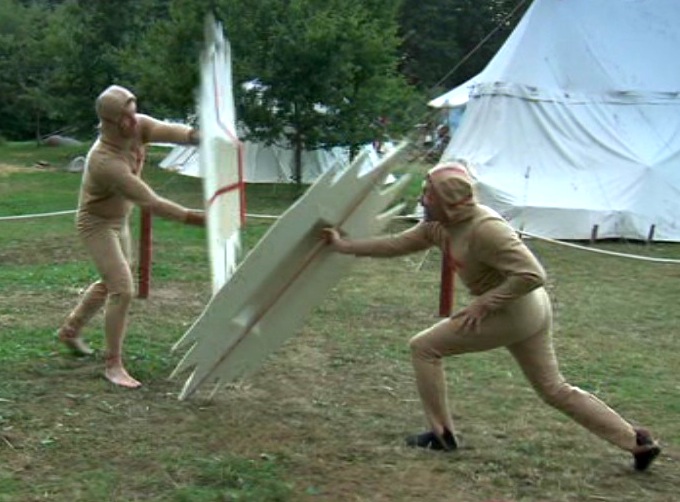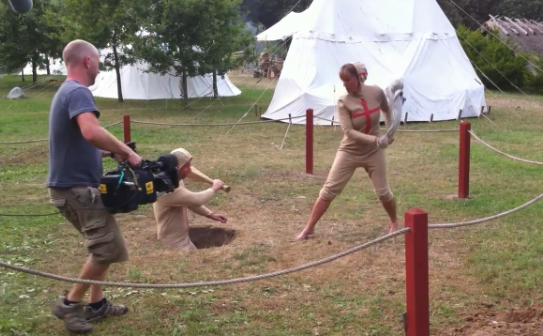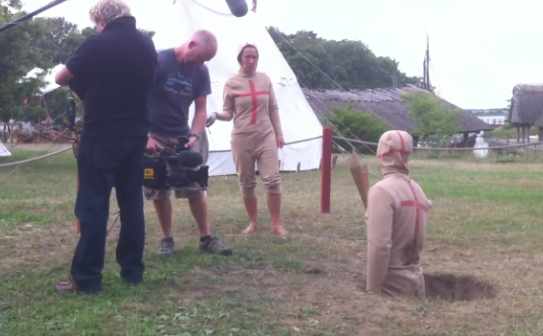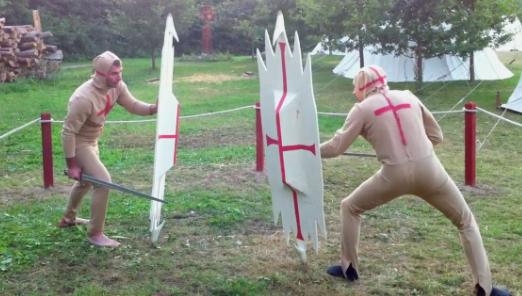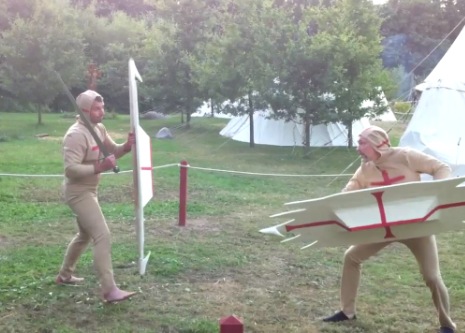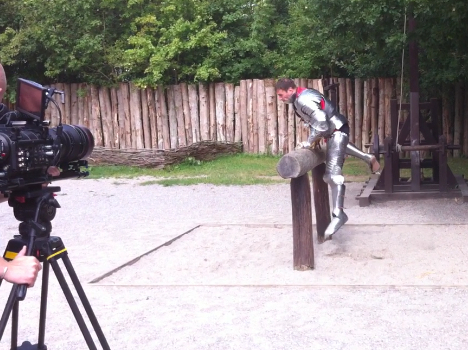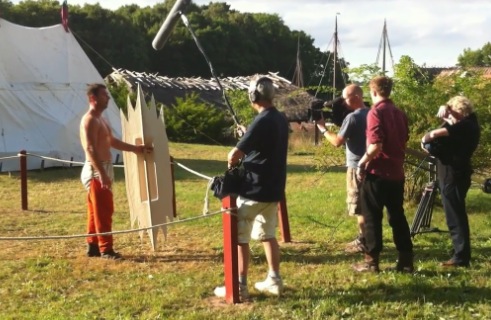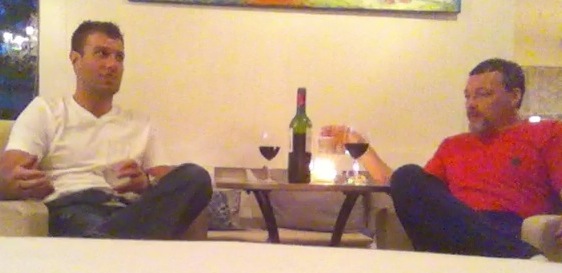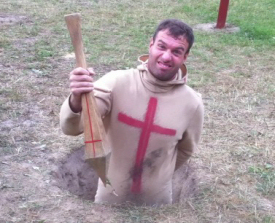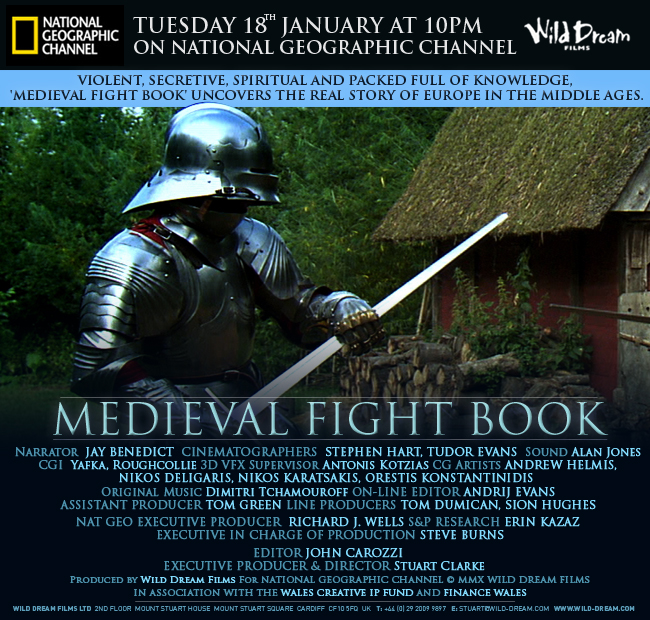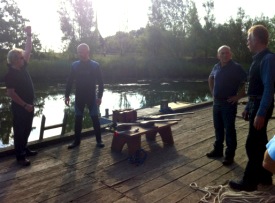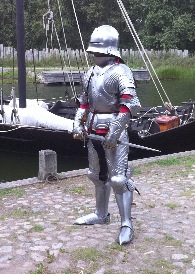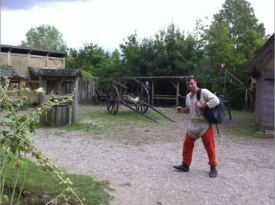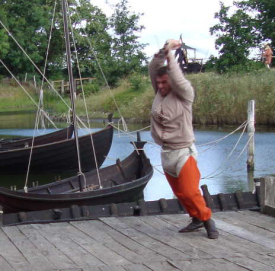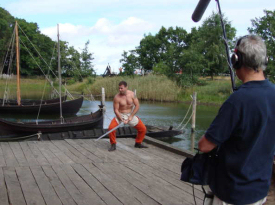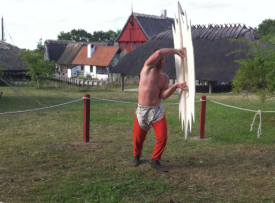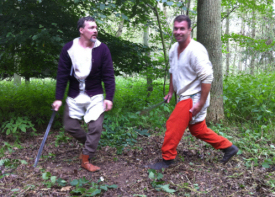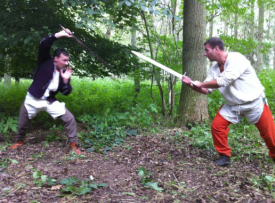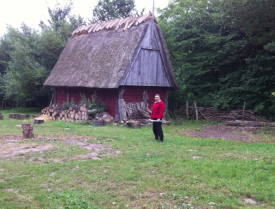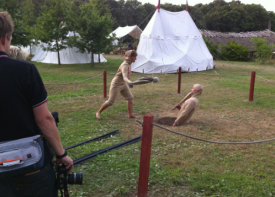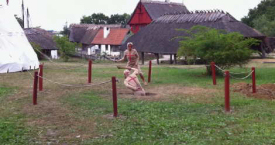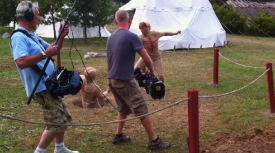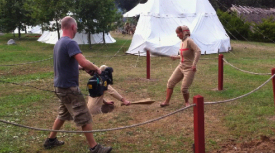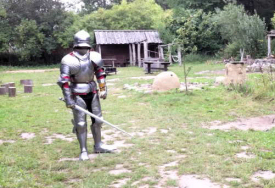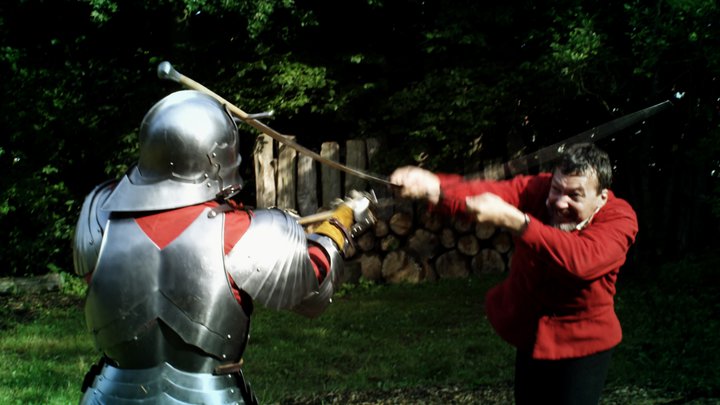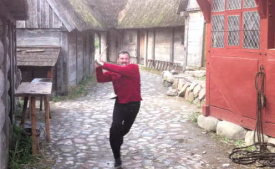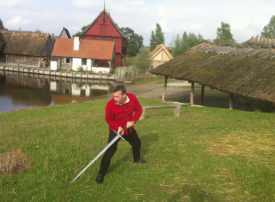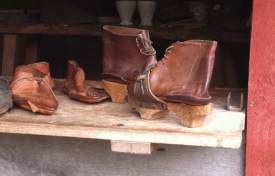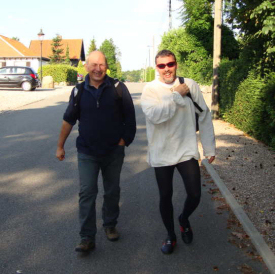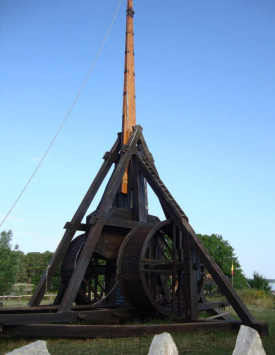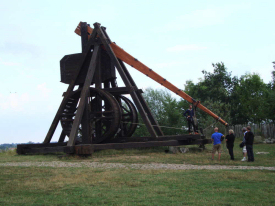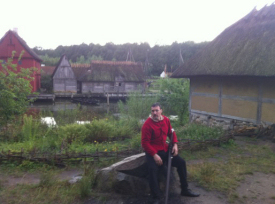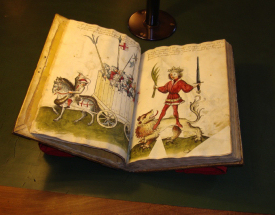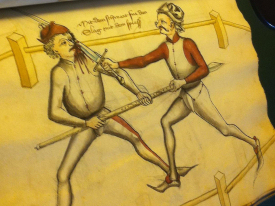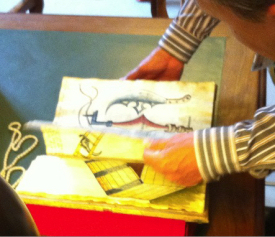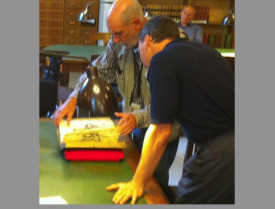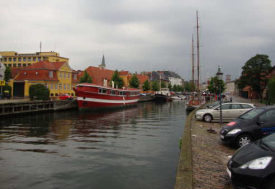Talhoffer's
Medieval Fight Book Blog
A journal
of working in Denmark for the National Geographic Channel program,
Medieval Fight Book,
produced by Wild Dream Films
By John
Clements
In October 2010, I was asked by the production company Wild Dream Films to write a "short" blog about some of my experiences as fight master and historical consultant for their program on the 1459 edition of Hans Talhoffer's Fightbook. As an expert in the subject of Medieval and Renaissance close combat, I was contracted to provide analysis and commentary plus arrange some select fight sequences and demonstrations of fighting techniques from Master Talhoffer's compendium.
In August
2010, my apprentice, Aaron
Pynenberg, and I traveled to the Denmark Medieval
Centre
in Nykobing Falster. We arranged some judicial fights and foot combat
demonstrations, filming scenes with longswords, messers, spiked duelling
shields, armored versus unarmored encounters, and, yes, the famous man-woman
"hole in the ground" judicial duel. As of this writing I have
no clue as to how much or what of our efforts will make it in the final
program nor what aspects of the many hours of material we performed will
be shown in what context.
The Wild Dream crew was supportive and great to work with, the director challenging, the location inspiring, the material demanding, and the experience invaluable. Everything went really well, considering. It was a grueling, exhausting, fascinating, educational, and wild time. We had 12-hour days on set, did hundreds of takes, and learned a huge amount.
Aaron
and I did several fight scenes and technique displays while I gave numerous
observations on Talhoffer and Late-Medieval Germanic sources of historical
European close-combat. In the process we did some interesting and
original things by displaying our new form of spontaneous fight execution
beyond any stage combat / stunt fencing of this type ever done before
on camera. Relying on an unrivaled mastery of authentic historical combat
techniques for creating never-before seen action we employed my unique
Spontaneous Arranged-Fighting Execution system - the "SAFE" method (TM).
Featuring an authoritative and pioneering program with a physically intense
and highly original alternative outside the box of current standards,
it offers a new alternative to the dry, over-used clichés of entertainment
industry fight director certification. The approach relies on martially
sound, historically accurate, and visually dynamic material.
Some Background: Talhoffer's Significance
- While
talking with the producers on phone and discussing Talhoffer on camera
for them, I tried to stress my opinion that the real significance of Talhoffer's
Fechtbuch is that it's the very
first historical source we have which illustrates the fighting techniques
of the late 14th and early 15th
century German masters of defence. While Talhoffer is somewhat underrated
and less appreciated by historical fencing students than important works
by other masters such as Johannes Liechtenauer, Sigmund Ringeck, and Hans
Leckuechner, it nonetheless represents some of the most elegant combat
artwork of the genre.
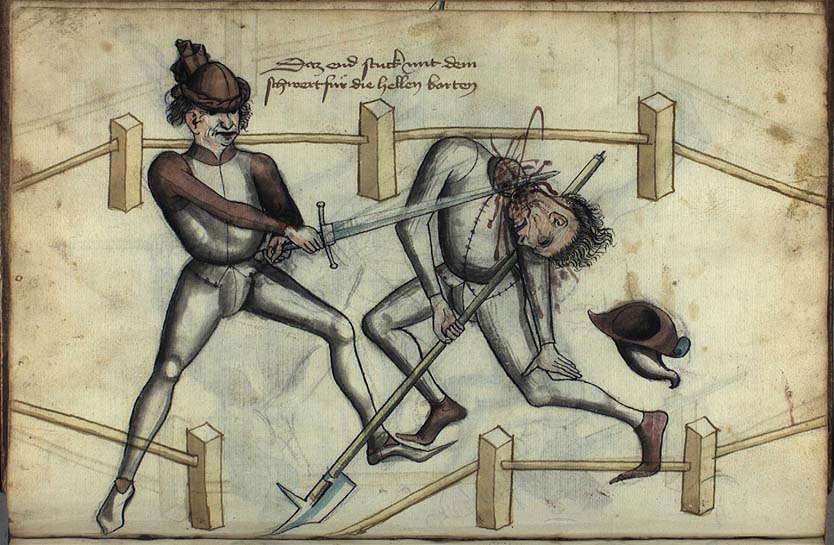 -
I first encountered the 1459 edition of Hans Talhoffer's Fechtbuch
about 20 years ago when I obtained a crude photocopy of the foot-combat
section. I recall being fascinated at seeing for the first time a treatise
on knightly fighting techniques that made it look wildly brutal yet obviously
skillful. It was a work that wasn't included in Egerton Castle's
famed 1885 book on Medieval and Renaissance schools of fence. Nor
was it described in any significant later histories on the subject, such
as Terrence Wise's underrated 1971 history of the art and science of personal
combat. Only one 19th century German academic work examined Talhoffer's
material and even then failed utterly to appreciate his importance.
-
I first encountered the 1459 edition of Hans Talhoffer's Fechtbuch
about 20 years ago when I obtained a crude photocopy of the foot-combat
section. I recall being fascinated at seeing for the first time a treatise
on knightly fighting techniques that made it look wildly brutal yet obviously
skillful. It was a work that wasn't included in Egerton Castle's
famed 1885 book on Medieval and Renaissance schools of fence. Nor
was it described in any significant later histories on the subject, such
as Terrence Wise's underrated 1971 history of the art and science of personal
combat. Only one 19th century German academic work examined Talhoffer's
material and even then failed utterly to appreciate his importance.
- Even from what little I knew about
the subject in the 1980s, I quickly discovered that 19th and 20th century
writers on the topic of 15th century close combat had gotten it all wrong.
They failed to grasp how the material represents martial
arts and not just "fencing." Talhoffer's content was so outside
of the depictions and misconceptions of pop culture's notorious misrepresentations
of Medieval swordsmanship and was certainly nothing like the familiar
parry-riposte style of baroque fencing that makes up the modern sport
form. The nature of the fighting presented in Talhoffer's illustrations
was also so radically different than what I had seen in various reenactment
and living history concoctions with their mock battle displays and pretend
knightly tournament games. Because of all this, Talhoffer's little
known work was instrumental in encouraging my own personal quest to learn
what actual fighting methods of this era were really about.
- Fast forward another ten years and
several editions of Talhoffer's treatise sat on my desk along side a dozen
other similar fight books from the 14th to 16th centuries. The power of
the emerging Web allowed enthusiasts the world over to share ever-improving
digital copies as well as thoughts and opinions on practicing the martial
arts teachings they contained. By the year 2000, I had already been incorporating
much of Talhoffer's techniques into my own training and instruction.
That same year I wrote an introduction to the first published English-language
translation of one edition, and soon after obtained fine replicas of the
very swords and weapons used in the work.
- Here I am now in the present, one
of the very few professional instructor-researchers of Medieval and Renaissance
fighting arts and the world's foremost proponent of the subject.
So, when I was invited to be involved in a special television program
(the first ever on a European master of Defense) on this unique and under-appreciated
work, I was more than eager. Asked to present realistic fighting action
in the style of his time, and coordinate and arrange historically accurate
combat sequences based on his treatise, I said absolutely! I knew my knowledge
in this field would be of great valuable in helping present Talhoffer's
fight book in a way that would showcase its artistic, cultural, and martial
significance.
Pre-Production Video Animation Work
 -
Before we learned when production was to actually begin, I was first called
on in July to create some 16-minutes worth of core-motion footage for Wild
Dreams' animators to work from in creating some CGI sequences from Talhoffer's
plates. The idea was to show how select techniques with longswords and messers
would have been performed and my task was to convey how the movements
would have likely started and ended, allowing them to reconstruct them via
animation. I first covered the ways for properly gripping the
swords, then displayed the basic form of the actions and the correct bio-mechanics
of the stances, footwork, and essential strikes. This way I was able
to give them via the Internet some key examples of how weapons
and limbs really flow and move in cutting violently from different positions.
I contrasted this from the over-used familiar movements so typical
of stunt-fencing and stage-combat. I also discussed with them the five mastercut
strikes, the intensity of sword blows, and my interpretations of the core
motions behind some of the more famous Talhoffer plates ---such as the hat
and dagger throwing image and the warhammer dismemberment as well as the
longsword beheading the bill-fighter.
-
Before we learned when production was to actually begin, I was first called
on in July to create some 16-minutes worth of core-motion footage for Wild
Dreams' animators to work from in creating some CGI sequences from Talhoffer's
plates. The idea was to show how select techniques with longswords and messers
would have been performed and my task was to convey how the movements
would have likely started and ended, allowing them to reconstruct them via
animation. I first covered the ways for properly gripping the
swords, then displayed the basic form of the actions and the correct bio-mechanics
of the stances, footwork, and essential strikes. This way I was able
to give them via the Internet some key examples of how weapons
and limbs really flow and move in cutting violently from different positions.
I contrasted this from the over-used familiar movements so typical
of stunt-fencing and stage-combat. I also discussed with them the five mastercut
strikes, the intensity of sword blows, and my interpretations of the core
motions behind some of the more famous Talhoffer plates ---such as the hat
and dagger throwing image and the warhammer dismemberment as well as the
longsword beheading the bill-fighter. - My sampleclips were used by Antonis Kotzias, the lead CGI animator, to create some fight sequences in the program. This was the first time an expert practitioner of fight-book material was used to produce animations of historically accurate 15th century combat techniques for film or broadcast. He later emailed me that the fight motion sequences I provided were a style he had never seen in any movie, documentary, or video game. It was very gratifying. But, man, it was a lot of work. I'm eager to see what they end up doing with it.
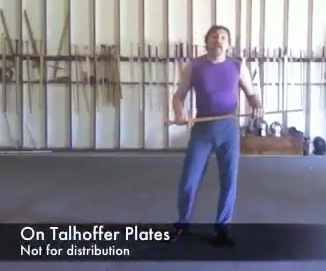 |
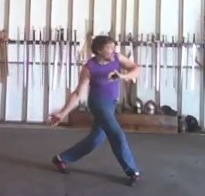 |
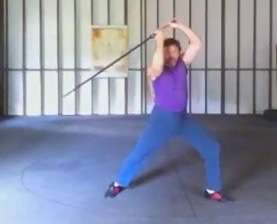 |
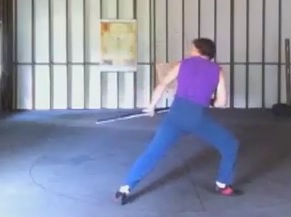 |
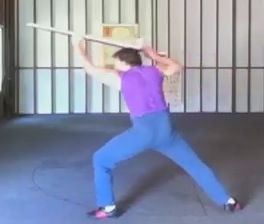 |
Air Travel Misadventures
- With only a few weeks to prepare
for the trip my training partner, Aaron, and I managed to ready ourselves
on short notice. Aboard our Delta/Air France flight from Atlanta
to Denmark an unfortunate passenger died of natural causes only a few
rows in front of us. We had to be diverted to Ireland for them to remove
the body. A two-hour layover there caused us to miss our connecting
flight from Paris to Copenhagen, resulting in the airline then losing
our baggage for two and a half days (!).
- When we landed at Charles De Gaulle
airport in Paris they have a bus to pick you up at the tarmac and take
you to the terminal to get your connecting flight. They had us all so
packed in tightly right off the plane -- hot, crowded, stuffy, reeking
-- that someone at one end throws up on the bus while at the other end
a woman passes out and collapses. People were trying to hold her
up and screaming to the driver to open the doors let us out or at least
open the automatic windows. But for several minutes he refused to respond
and ignored everyone as we just sat there waiting for our turn to disembark.
It was bizarre.
- These hassles cost us a number of
schedule problems. We had Aaron's hundred pound box of armor with us,
but that was mostly it. And without his gambeson (padded under garment)
that was packed in another bag he couldn't wear his armor! All the
clothing we had with us for the first two days of the shoot was what was
in our carry-ons — which, because of past experiences, I wisely
included assorted items just in case they lost our luggage. Anyway,
it all caused a great inconvenience for us the first two days of shooting.
During the judicial shield duel scene, for instance, I couldn't go barefoot
as I should have because all I had to wear underneath the flimsy felt
costume (which was the wrong color and fit terribly) was one pair of thin
stocking tights. And my borrowed leggings didn't fit properly either.
Then, because of other issues, Aaron didn't have historical pants for
his armor nor did he have the proper maile gussets or maile girder under
his harness. I'm sure that will be an issue for him with the "history
police" when they the program airs (and rightly so, I say).
Talhoffer's "Cookbook"
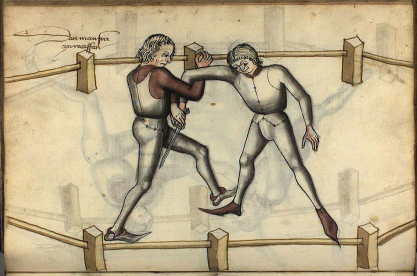 -
It might be best to describe Talhoffer's 1459 Fechtbuch
("fight book") as being just a portion of his Kriegsbuch,
or war book, which contains a fascinating collection of devices, machinery,
and presentation material on various military arts and sciences. The material
on fighting skills (which was almost exclusively my area of professional
interest and certainly my personal fascination) is the work's largest
portion. Within that, it features sections on primarily foot combat, itself
dominated by examples of unarmed and dagger-fighting techniques. This
is followed by substantial material on fighting with the sword and buckler,
the longsword, pole-axe in armor, and then a large segment on various
kinds of fighting for trial by combat with special duelling shields.
-
It might be best to describe Talhoffer's 1459 Fechtbuch
("fight book") as being just a portion of his Kriegsbuch,
or war book, which contains a fascinating collection of devices, machinery,
and presentation material on various military arts and sciences. The material
on fighting skills (which was almost exclusively my area of professional
interest and certainly my personal fascination) is the work's largest
portion. Within that, it features sections on primarily foot combat, itself
dominated by examples of unarmed and dagger-fighting techniques. This
is followed by substantial material on fighting with the sword and buckler,
the longsword, pole-axe in armor, and then a large segment on various
kinds of fighting for trial by combat with special duelling shields.
- My view toward the program's content
was that this bound manuscript represents something like a cookbook, in
that there are recipes on various appetizers, main courses, side dishes,
and desserts. The producers, for whatever reasons, wanted to forgo focusing
on the dishes that make up the delicious entrées and tasty sides in favor
of emphasizing appetizers and desserts. Since the main interest of the
director was the man-woman judicial combat and the fight with duelling
shields, this meant us presenting mostly generalities about the kind of
fighting Talhoffer's work portrays and then featuring a handful of specific
actions from selected plates.
- My only real complaint with the vision
of the production was that, if you look at this edition of Talhoffer half
of it has to do with combat arts. So, half the program should reasonably
be about that. But instead, these elements got downplayed from what we
could tell on set. Additionally, a tiny, tiny fraction of the work depicts
mounted combat and only a few pages show armored combat (with the rest
being unarmored longsword, buckler and messer, and then the judicial material).
But there was all this seeming emphasis being placed on mounted activities.
Made no sense to me. In my opinion that stuff has been done to death in
TV documentaries already. But, it wasn't my place to comment on this.
- As with
the nature of much documentary filmmaking, there is often no real
script to go on just the director's general idea of what's to be captured
on camera. The larger vision doesn't come together really until editing.
So, we were not sure at all what angle the production was going to take.
All we knew for sure was that Talhoffer's martial arts material was
not center stage. As far as we could figure during our time working on
it was the program would emphasize how "mysterious" the manuscript's "enigmatic"
content was.
Judicial Duels and Trial by Combat
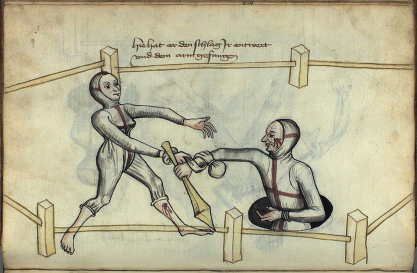 -
Judicial duelling makes up a good portion of the fighting material in
Talhoffer's fight book. Such contests were essentially trial by combat,
a religious and legal ordeal that let certain disputed matters or criminal
cases be settled by fighting it out when neither side could be judged
according to anything but their own word. In a world often ruled by force
it was a right afforded to the warrior class, or noble knights, but sometimes
commoners were permitted to engage in a form of it. As opposed to
single combat challenges such as chivalric duels or later private duels
of honor, a man (and in rare instances, a woman) would be obliged by authority
to enter into a judicial combat. He might be typically given a month or
two to prepare himself. Certain formalities and ritual dictated the setting
and conditions. Much of the surviving fight-book literature deals with
how to survive such combat. Such occasions could be huge spectacles for
the community, sort of akin to a combination celebrity court case, political
scandal, MMA championship, and public execution all rolled into one.
In German regions at this time commoners as well as woman sometimes engaged
in such combats. Unlike knights, they would often required to wear a strange
tight-fitting body suit (perhaps a ritual or burial outfit).
-
Judicial duelling makes up a good portion of the fighting material in
Talhoffer's fight book. Such contests were essentially trial by combat,
a religious and legal ordeal that let certain disputed matters or criminal
cases be settled by fighting it out when neither side could be judged
according to anything but their own word. In a world often ruled by force
it was a right afforded to the warrior class, or noble knights, but sometimes
commoners were permitted to engage in a form of it. As opposed to
single combat challenges such as chivalric duels or later private duels
of honor, a man (and in rare instances, a woman) would be obliged by authority
to enter into a judicial combat. He might be typically given a month or
two to prepare himself. Certain formalities and ritual dictated the setting
and conditions. Much of the surviving fight-book literature deals with
how to survive such combat. Such occasions could be huge spectacles for
the community, sort of akin to a combination celebrity court case, political
scandal, MMA championship, and public execution all rolled into one.
In German regions at this time commoners as well as woman sometimes engaged
in such combats. Unlike knights, they would often required to wear a strange
tight-fitting body suit (perhaps a ritual or burial outfit).
- Judicial combat has never been an
interest of mine nor anything I really get excited over, but that was
a major portion of what we ended up doing, such that we didn't get to
indulge the director in our expertise with the longsword nor on armored
combat they way we had hoped. Instead, we had to present other things
that were less interesting and less reflective of our skills in the knightly
art of 15th century Germanic fighting. Still, it was all great experience
and there's some things on camera that's never been done before and they
told us several times they were really, really pleased with the action
and dynamism of what we displayed. In fact, the production crew
and animators sent me more than one note reading: "We have been studying
your moves a lot from the previous videos you have sent, I'm not an expert
on martial arts but I have never seen this style of fighting in any movie
documentary or game. I hope we do it justice in representing it properly."
The Challenge of Matching Martiality with Theatricality
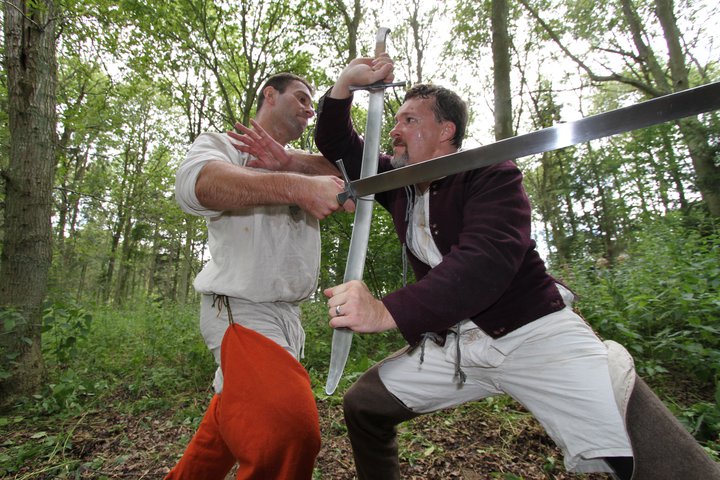 -
Our challenge in this project was essentially: how do we arrange these
fight scenes to meet the needs of the director but at the same time display
the inherent violence in brutality of this type of combat (meaning late-14th
/ early-15th century Germany) in a way that would reflect the techniques
and methods from Talhoffer's fight book? And how to do this in the
way we know —that is, in a manner that hasn't been seen before with
the standard cliché theatrical/stage-fighting arrangement? This
has nothing to do with the usual laments by choreographers about time
and space constraints or creative freedom, but rather offering up a different
method to the standard theatrical theories of Medieval and Renaissance
close-combat and the distorted physicality by which they're typically
misrepresented.
-
Our challenge in this project was essentially: how do we arrange these
fight scenes to meet the needs of the director but at the same time display
the inherent violence in brutality of this type of combat (meaning late-14th
/ early-15th century Germany) in a way that would reflect the techniques
and methods from Talhoffer's fight book? And how to do this in the
way we know —that is, in a manner that hasn't been seen before with
the standard cliché theatrical/stage-fighting arrangement? This
has nothing to do with the usual laments by choreographers about time
and space constraints or creative freedom, but rather offering up a different
method to the standard theatrical theories of Medieval and Renaissance
close-combat and the distorted physicality by which they're typically
misrepresented.
- For people like myself, as an experimental
historian, a specialist, a martial artist, we can have a deep and personal
relationship with the source materials. We're often intricately
familiar with and involved in practicing the principles and techniques
their teachings contain. Thus, we couldn't help but bring a very different
approach and perspective to this kind of project – even though we
felt the producers weren't capitalizing on what we can do and allowing
us to fully display our unique expertise and skill set – which,
I maintain, is a decidedly different conception (and indeed, superior)
vision of historical close-combat to that of what film and TV producers
have for so long given the public via the usual stunt fighting industry.
(This made all the more clear when you actually catch in the program a
few seconds of the shadowy silhouettes of two fighters bashing longswords
edge on edge in slow motion ---yet more of the same old historically inaccurate
and martially unsound stunt-fighting re-enactment silliness that we abhor.)
Being known myself as a long-time critic of the historical and martial
misrepresentation so endemic to much of stage-combat in film and television,
I am fully confident my work cannot but have a distinct look.
Many of the seemingly realistically vicious moves we do we achieve by
use of a natural broken tempo and broken rhythm delivered just off target
or just out of range than we would normally do if we were sparring.
Fighting for entertainment/dramatic impression is always about creating
illusion but the best illusions are those that seem to be real. Accomplishing
this is easiest when you can do it for real to begin with.
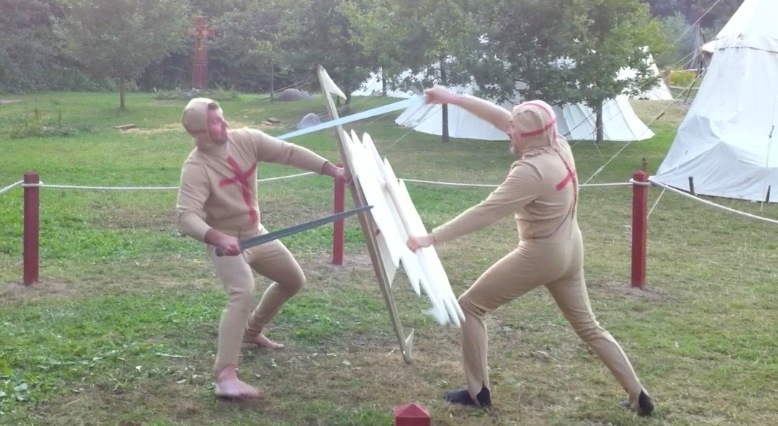 -
Because of the necessity in film or TV to do multiple takes of an exchange
or to repeat a fight sequence over and over until the director's satisfied
he has what he needs, Aaron and I became instantly aware that (obviously)
after doing something twenty, thirty, or forty times with the force and
intensity that we practice our moves it was losing that sense of urgency
and spontaneity that we prize. We know what is reflective of authentic
martial intent, and what looks better than the usual pretend combat, so
what we had to do was stop and say something like: Okay, you know what
we're doing at the moment is losing that sense of real physical and emotional
energy as we're getting overly familiar with it here and it's losing the
naturalness we like and the subtle but all-important element of immediacy
you find in real fighting. So, we would stop; break the action, break
the rhythm, break the tempo, do a few other moves to reset and re-energize
ourselves then resume what we had been doing. This way in our fight
scenes we captured that urgency and excitement we try to convey with real
techniques but is lost in virtually all fight choreography of this kind.
-
Because of the necessity in film or TV to do multiple takes of an exchange
or to repeat a fight sequence over and over until the director's satisfied
he has what he needs, Aaron and I became instantly aware that (obviously)
after doing something twenty, thirty, or forty times with the force and
intensity that we practice our moves it was losing that sense of urgency
and spontaneity that we prize. We know what is reflective of authentic
martial intent, and what looks better than the usual pretend combat, so
what we had to do was stop and say something like: Okay, you know what
we're doing at the moment is losing that sense of real physical and emotional
energy as we're getting overly familiar with it here and it's losing the
naturalness we like and the subtle but all-important element of immediacy
you find in real fighting. So, we would stop; break the action, break
the rhythm, break the tempo, do a few other moves to reset and re-energize
ourselves then resume what we had been doing. This way in our fight
scenes we captured that urgency and excitement we try to convey with real
techniques but is lost in virtually all fight choreography of this kind.
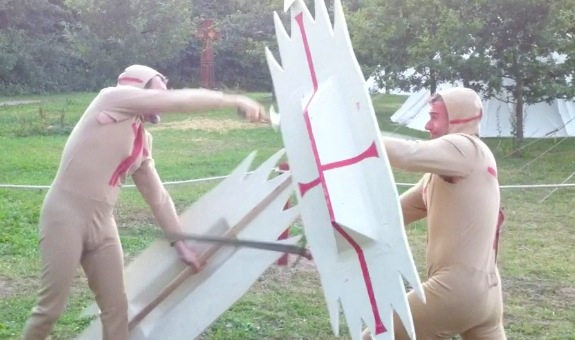 -
What we did half the time for the fighting portions was a vigorous energetic
free-play within an exchange of certain prepared moves and set outcome.
It was a mixture of motion sequences and fighting techniques that we're
not quite reenactment but we're certainly not your traditional Hollywood
choreographed nonsense. The rest of the time our fights were just
performance of a specific strike and counter-strike routine, but delivered
with an increased emotionality for dramatic impact. If the final edit
retains this I think it will prove a refreshing experience to viewers.
-
What we did half the time for the fighting portions was a vigorous energetic
free-play within an exchange of certain prepared moves and set outcome.
It was a mixture of motion sequences and fighting techniques that we're
not quite reenactment but we're certainly not your traditional Hollywood
choreographed nonsense. The rest of the time our fights were just
performance of a specific strike and counter-strike routine, but delivered
with an increased emotionality for dramatic impact. If the final edit
retains this I think it will prove a refreshing experience to viewers.
- Given the quality of the cinematography and camera, the superb location/setting, the quality of the blades used, and the quality of my partner, as well as the free-hand we were given to specifically present historically accurate fighting techniques, I expect the final result (...fingers crossed) to be among the best work I have ever done for commercial broadcast or film.
On and Off the Set
- Throughout the production there were
a number of location issues with tourists, animals, background noises,
people in frame, etc. As would be expected, several seemingly great takes
had to be redone. While I mostly occupied myself with mentally running
through our sequences and portrayal of the physicality of this kind of
combat, it was harder on Aaron who spent several hours in authentic plate
armor just waiting around only to then be called on to perform some feat
of running, jumping, climbing, floryshing, etc., seven, eight, or nine
times in a row. Glad I wasn't him. Lol.
- At one point during a take I had
to refer to "chain maile," instead of using the proper term, maile,
because the director preferred it (I should have said, "the chain-link
armor called maile, often mislabeled chain mail." But I didn't).
It was rough doing exactly what was requested and not offering or interjecting
too much so that it interfered, yet at the same time present the expertise
and advice that we were brought in for. We were definitely not used
to working that way and there was some frustration in dealing with the
challenge. But, hey, they were the employers. I was just there to do the
best job for them I could. As an authority on historical arms and
fighting methods the bottom line that was important to me: We were exclusively
in control of the fight sequences. For the first time a real expert in
the subject was coordinating realistic combat action and directing authentic
historical encounters for television. Can't complain about that.
 -
We also got to work some with the esteemed action arranger, Mike Loades,
who was on set at the Medieval Center to discuss trebuchets and mounted
combat for the program. Mike also ended up helping out with Aaron's armor
a few times and offering some comments on Talhoffer. Mike's a fascinating
guy with a long career in stage combat and theatrical fencing as well
as exploring historical weapons and military technology. He is a pioneer
in presenting historically accurate combat for film and television as
well as a life-long explorer of arms and armor in his own right. I've
been viewing him on TV shows since I was a teen and had the pleasure of
meeting him a decade earlier. So it was a bit surreal for me to
actually have him around for so much of the week. Though the foot combat
fighting skills of MARE (that is, the "martial arts of Renaissance Europe")
are not his area of special expertise, I have a great admiration and respect
for Mike's extensive body of work and unmatched experience in the industry.
He was a delightful curmudgeon as well as a kindred spirit. Aaron and
I were not quite sure at times if he fully appreciated the perspective
we were bringing to the project, though it wasn't as if we really had
opportunity to go over it with him the way we would have if we weren't
all so busy working.
-
We also got to work some with the esteemed action arranger, Mike Loades,
who was on set at the Medieval Center to discuss trebuchets and mounted
combat for the program. Mike also ended up helping out with Aaron's armor
a few times and offering some comments on Talhoffer. Mike's a fascinating
guy with a long career in stage combat and theatrical fencing as well
as exploring historical weapons and military technology. He is a pioneer
in presenting historically accurate combat for film and television as
well as a life-long explorer of arms and armor in his own right. I've
been viewing him on TV shows since I was a teen and had the pleasure of
meeting him a decade earlier. So it was a bit surreal for me to
actually have him around for so much of the week. Though the foot combat
fighting skills of MARE (that is, the "martial arts of Renaissance Europe")
are not his area of special expertise, I have a great admiration and respect
for Mike's extensive body of work and unmatched experience in the industry.
He was a delightful curmudgeon as well as a kindred spirit. Aaron and
I were not quite sure at times if he fully appreciated the perspective
we were bringing to the project, though it wasn't as if we really had
opportunity to go over it with him the way we would have if we weren't
all so busy working.
- For both Aaron and I, the whole
hurry up and wait pattern of being on set was no problem. Aaron deals
with that professionally as a veteran police officer, and I, being former
military myself as well as a long-time martial arts instructor had no
self-discipline concerns. Besides, how could we ever really be bored
on the location of Denmark's gorgeous Medieval Center. The 15th
century scenery, the buildings, the ambiance, the extraordinary attention
to detail, all gave a real sense of milieu that encouraged the right mindset.
For myself, being in historical garb with replica weapons at that location
kept me fixed on the subject in a way I have never felt before.
It was very cool. Besides, we also knew what our call times were and when
we were nearing the end of the shoot each day and this helped us stay
pumped.
Tools of Choice
- The
historically accurate replica swords loaned for this shoot from Albion
Swords were invaluable. All the weapons we had on hand from them
performed flawlessly and everyone who handled them was very impressed
(oddly, most had never even heard of Albion!). As a professional swordsman
and consumer advocate for historical fencing — with no business
relationship with Albion — I can say I honestly consider them the
finest reproduction swords available. Several of their models are
among my favorite off-the-shelf pieces that are without question the best
I have ever used. Their "Regent" longsword astonished everyone with
what it permitted me to perform and their "Talhoffer" longsword was the
perfect match to the whole project. Both the "Regent" and "Talhoffer"
models got a lot of use on camera. I hope a good portion of this
appears in the final edit. Both those swords are tremendous. I have said
before, they are two of the most beautiful and perfect replicas I have
ever had the pleasure to train with. The "Regent" in particular is currently
the most favored reproduction sword that I own.
- Albion's new training Messers (short
single-edged blunt practice blades) that we also had the pleasure of borrowing
for this shoot were beautiful. We barley got to use either their "Liechtenauer"
or "I.33" model practice-swords, but the Messers got a world-class work
out on and off camera. They handled superbly and held up fantastically
to sparring and practice fighting! Using one is like driving a Porsche.
Indeed, they are really unbelievable to play with. These things are one
of the most exciting tools I have ever used for practice. I am in love
with them. They are so robust and sturdy they are a complete and total
joy to fight with. They were an absolute blast and allowed us to perform
all manner of full-speed close-in contact strikes and high-impact wardings.
I am anxious to see what makes the final cut from our many hours of fighting
with them on camera.
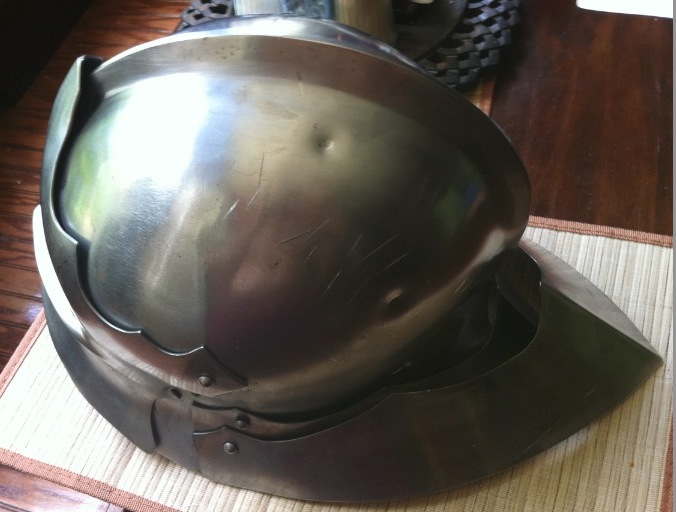 -
At one point the "Talhoffer" sword was filmed being used to strike repeated
high-speed blows against Aaron in his Gothic plate armor. Though it looked
pretty fierce, I hit him with only about 80% force, and though his helm
and armor were scratched and dented, the blade's edge wasn't affected
in the least that I could tell. It was a remarkable demonstration of their
quality. I am really looking forward to seeing how this looks in HD. I
can't recall something like this ever being done for television before.
(Amusingly, right after making these cutting blows the director, Stew,
asked me to then continue on to next demonstrate how thrusts would work
on armor instead and I replied, "Uhhh...no. Not with a sharp weapon."
Aaron and I exchanged bemused looks and I could see him grinning with
relief under his helm. Lol.) Later,
we could see the cut-like scratches the helm suffered.
-
At one point the "Talhoffer" sword was filmed being used to strike repeated
high-speed blows against Aaron in his Gothic plate armor. Though it looked
pretty fierce, I hit him with only about 80% force, and though his helm
and armor were scratched and dented, the blade's edge wasn't affected
in the least that I could tell. It was a remarkable demonstration of their
quality. I am really looking forward to seeing how this looks in HD. I
can't recall something like this ever being done for television before.
(Amusingly, right after making these cutting blows the director, Stew,
asked me to then continue on to next demonstrate how thrusts would work
on armor instead and I replied, "Uhhh...no. Not with a sharp weapon."
Aaron and I exchanged bemused looks and I could see him grinning with
relief under his helm. Lol.) Later,
we could see the cut-like scratches the helm suffered.
- The producers also had a custom-made
sword created specifically for this program of a style of spiked warsword
that appears in Talhoffer's work. The hilt simply has sharp points
on its cross and pommel but otherwise the weapon is unremarkable.
Unfortunately, the design of the replica sword they obtained had an incorrect
center of gravity with an inappropriate cross-sectional geometry (a common
mistake in my opinion when swordmakers don't properly consult expert fighters
or copy the exact blade profiles of existing specimens very closely).
So, we declined to use it for any demonstrations. And because it was sharp
rather than blunt we couldn't have done any fight scene action with it
anyway. There were also several other issues with it that prevented presenting
a sword like this the way we would have liked or employing it in a more
inclusive manner. I had told them earlier that all they really needed
was to have a new hilt of this style made for any number of dependable
blades but they chose to go in another direction. Oh well. Too bad.
No real loss.
Combat Techniques and Talhoffer's Duels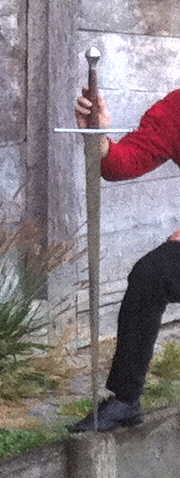
"Act like you're fighting, not fight like you're acting."
- Normally,
fight arrangers, choreographers, or stuntmen would get to examine and
prepare their gear and props well in advance. In this case we didn't.
The wooden duelling club the production company had made for the judicial
combat was insane for doing any mock fight with. It was real and quite
lethal, essentially being a heavy, solid, reproduction with a sharp point
and edged corners. We had to work around it. Meanwhile the woman's flail
was ridiculously unrealistic, being nothing more than a tennis ball wrapped
in some layers of duct-tape. It had neither the mass nor balance
of the real thing and gave no impression of having to be wielded as if
it were a large stone inside of a cloth wrapping. It bounced and
rapidly whipped all around. …Ugggh.
- Aaron
took a few hours to work with a volunteer from the Medieval Center (a
former nurse named Pia) who proved an apt actress and fight student. She
was wonderful for the role of the woman in the judicial duel. I
think the results are again testament to our method. As before,
in keeping with our philosophy of arranging fight exchanges rather than
trying to "choreograph" an artificial armed "dance routine" of sequential
movements, we instead focused on her conveying appropriate "martial intent."
The goal was presentation of the genuine physicality associated with fighting
in earnest to defend one's life in a violent encounter like this. She
was given just a few actions to perform repeatedly within the context
of appearing to naturally seek range and timing. This holistic approach
worked wonders, as we knew it would. She looked good and the director
was pleased with how realistic the effect was on camera. There wasn't
any time wasted in trying to make some memorized fake techniques look
passable or go through a programmed series of back and forth movement
lessons with a novice. Following our method, instructed: "Instead
of fighting like an actor, act like a fighter." Big difference.
- I also took a few moments out with
Pia beforehand to show her some very simple intuitive lessons that powerfully
convey certain crucial aspects of the nature of fighting so that she was
able to holistically grasped just what we meant by the importance of having
the right martial mindset. Of course, because her fake stone flail weapon
was harmless, Aaron was able to tell her to go ahead and try to really
make contact and actually hit him. The director was able to then
call out when he wanted her to strike him on the arm or head so that Aaron
responded accordingly to the blows when they actually landed. The main
concern for us was how to teach a non-fighter to act as if it was a life
and death situation and handle their harmless mock weapon as if it were
lethal. Meanwhile Aaron had to refrain from possibly injuring her with
the authentic wooden club while still making it look like a legitimate
contest fought with real emotion. And all this had to be done while wearing
confining clothing that we had to make sure we didn't tear or rip. Whew…
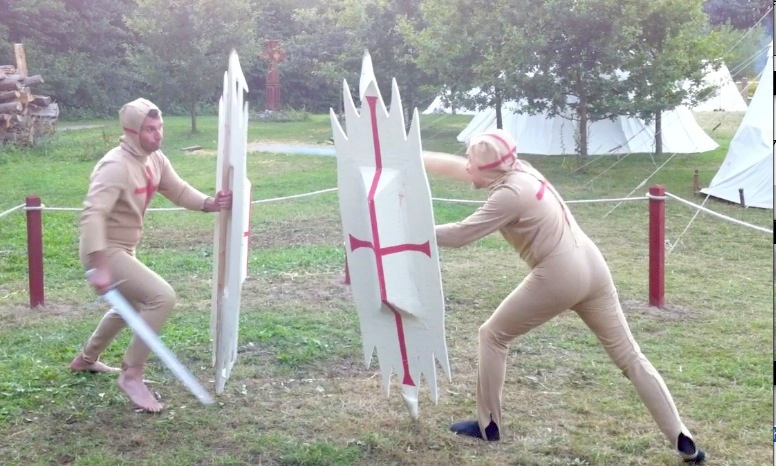 -
The two spiked dueling shields were pretty horrible to use, unfortunately.
Although the craftsmanship was pretty decent, not only were they much
too heavy and dangerously sharp (requiring rounding off the spikes before
we could use them), but they had unsuitable handles that were far too
thick in the center to properly grip. We couldn't possibly move them correctly
nor simultaneously hold another weapon while holding the shaft as Talhoffer's
images show. (I suspect these shields were produced by prop makers
or, more likely, by reenactors who typically need extra thick versions
to withstand repeated intentional bashing by the limited strikes of their
mock combat method, as opposed to training with a functionally maneuverable
shield like the kind you would want to defend your life with.
-
The two spiked dueling shields were pretty horrible to use, unfortunately.
Although the craftsmanship was pretty decent, not only were they much
too heavy and dangerously sharp (requiring rounding off the spikes before
we could use them), but they had unsuitable handles that were far too
thick in the center to properly grip. We couldn't possibly move them correctly
nor simultaneously hold another weapon while holding the shaft as Talhoffer's
images show. (I suspect these shields were produced by prop makers
or, more likely, by reenactors who typically need extra thick versions
to withstand repeated intentional bashing by the limited strikes of their
mock combat method, as opposed to training with a functionally maneuverable
shield like the kind you would want to defend your life with.
Historically, a shield had to be easy to manage and was considered a disposable item, not something to preserve. But since no surviving version of Germanic dueling shields survive, modern makers have to guess at their design and that leads to major problems if historical martial arts practice is not the motive. So, with these clumsy things, we quickly worked out a handful of safe but brutal looking exchanges that we forcibly executed with feigned violence. We just repeated them with rapid use of some basic footwork, fighting wards, and core motions.
- Aaron and I had only brief time to play with the spiked shields in order to get a feel for what we could and couldn't safely do or realistically perform, just as for the problematic wooden club and "rock flail." One again, I will say that being able to call on an immense repertoire of historical fighting techniques and deep knowledge of how the real weapons perform and handle got us through. Our expertise with the authentic fighting skills of the era combined with our appreciation for the reality of this kind of personal violence gave us the tools to pull it off. While we continually felt we did poorly compared to what we knew we could do, the director kept showing us the footage right after in the monitor and damn did they make us look good. It's amazing what you can do when you know how to handle real weapons in the real manner.
- Interestingly,
Aaron also commented that though he had never trained with such a weapon
he felt very comfortable with it nonetheless because in his profession
work as a SWAT officer the tactical shield is his specialty. He said he
felt an immediate affinity for the weapon and I can attest to how adroit
he immediately was with it.
- We also engaged in an impromptu session
of arming swords with dueling shields just as depicted in Talhoffer's
work. This proved quite difficult, as the shields were so unwieldy due
to their heavy weight and overly thick handles. We saw that we could
have stabbed each other in the foot with either the sword or the shield
spikes pretty easily (and in fact, had to be careful of accidentally doing
so). When planted in the ground the shields acted like a wall you could
fight around, but it still left you relatively blinded to your opponent.
Several times I managed to hook my spikes on Aaron's spikes and force
his shield to turn. I also achieved this with a good kick. He was very
aggressive though and his greater strength proved a big advantage with
these things. We ended up blindly trading sword thrusts all around
and over the shields until we decided such moves were just too hazardous
and unpredictable to employ for the sequence. The director liked
it though and asked us to repeat the exchange several times. All
we really did was bash weapons back and forth on each other shields while
feinting and dodging. Employed with a broken rhythm, aggressive motions,
and a lot of feigned apprehension it actually looked pretty darn good
from what we saw on the monitor.
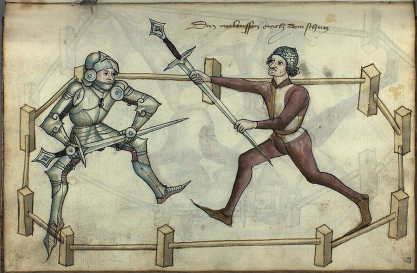 -
At one point on the grounds of a reconstructed 14th century farmhouse
we were reproducing the sole plate of from Talhoffer showing an unarmored
man going up against a fully armored opponent. This was the infamous Mortschlag
or "death blow" where the blade is gripped in both hands to throw a bashing
hit with the hilt. It's a fairly common technique with the longsword.
But in this instance we were restricted by lighting and directing to executing
it within a small, one-meter by three-meter area of wet straw during drizzling
rain (!). For safety, I also had to be really careful to not
hit with the cross-bar for that would have definitely caused real damaged.
To deliver the action for the camera we had to constrict our movements
down to a bare minimum of motion to still get the proper martial context
and range. And then we had to give it 5 or 6 takes until the director
was satisfied. Several times Aaron and I had to stop to catch our
breath and we agreed that the conditions were far from optimal to do our
best work or act with good historical form and proper intent. We had to
tell the crew at times that we just couldn't do a few of the things they
were asking.
-
At one point on the grounds of a reconstructed 14th century farmhouse
we were reproducing the sole plate of from Talhoffer showing an unarmored
man going up against a fully armored opponent. This was the infamous Mortschlag
or "death blow" where the blade is gripped in both hands to throw a bashing
hit with the hilt. It's a fairly common technique with the longsword.
But in this instance we were restricted by lighting and directing to executing
it within a small, one-meter by three-meter area of wet straw during drizzling
rain (!). For safety, I also had to be really careful to not
hit with the cross-bar for that would have definitely caused real damaged.
To deliver the action for the camera we had to constrict our movements
down to a bare minimum of motion to still get the proper martial context
and range. And then we had to give it 5 or 6 takes until the director
was satisfied. Several times Aaron and I had to stop to catch our
breath and we agreed that the conditions were far from optimal to do our
best work or act with good historical form and proper intent. We had to
tell the crew at times that we just couldn't do a few of the things they
were asking.
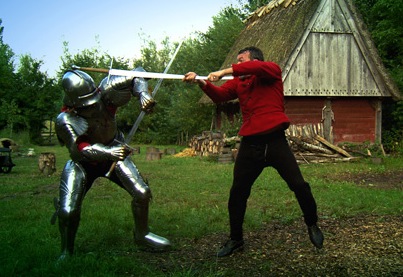 -
At this point, late in the second day
of shooting, Aaron was physically and mentally exhausted. His stamina
is impressive, but hours of running around in his armor, doing take after
take, still suffering some horrendous jet lag and loss of sleep, as well
as being off of a regular eating schedule took its toll on him. When I
conked his helm with this ferocious pommel strike he dropped like a rock
from the ringing blow. It momentarily stunned him and put a small nickel-sized
dent on his sallet helm. He collapsed to his knees then went down on all
fours for several seconds. I knew he had reached his limit. I quietly
asked, "Dude, you alright?" But he was so nauseous from overexertion he
just groaned the way he does when he's totally wasted from training or
a late night out. The crew naturally was nervously concerned, but
not being fighters or martial artists they're simply not use to the knocks
and blows we take for granted as part of serious training and sparring.
The tremor went right through him to his legs he told me. It took
him several minutes to catch his breath.
-
At this point, late in the second day
of shooting, Aaron was physically and mentally exhausted. His stamina
is impressive, but hours of running around in his armor, doing take after
take, still suffering some horrendous jet lag and loss of sleep, as well
as being off of a regular eating schedule took its toll on him. When I
conked his helm with this ferocious pommel strike he dropped like a rock
from the ringing blow. It momentarily stunned him and put a small nickel-sized
dent on his sallet helm. He collapsed to his knees then went down on all
fours for several seconds. I knew he had reached his limit. I quietly
asked, "Dude, you alright?" But he was so nauseous from overexertion he
just groaned the way he does when he's totally wasted from training or
a late night out. The crew naturally was nervously concerned, but
not being fighters or martial artists they're simply not use to the knocks
and blows we take for granted as part of serious training and sparring.
The tremor went right through him to his legs he told me. It took
him several minutes to catch his breath.
- About twenty minutes later he was recuperated but by then the day was over for our scenes anyway. The real issue to me was that he wasn't wearing a proper arming cap under his helm (for which I later chewed him out!) and a recent concussion from a gunshot that went off near his ear triggered a total loss of balance from the ringing blow, and so down he went. He later told me that his equilibrium was so off from an inner ear issue that for a few seconds he really thought he was going to puke in his helmet. (The photo here shows the two dents made by the wicked pommel blows.)
- I have to say, when it comes to facing armor I thought if I had to I could take on an armored opponent while unarmored and use greater agility and speed to get at his weak spots with thrusts. No chance. Aaron knows how to fight in armor and facing him was quite intimidating, even without the wet ground and drizzling rain and restrictions on how much we could step and move in that confined space, I know I could not have gotten a thing in on him. We were using the Albion feder-sword blunts for this and had warmed up with some free play in between takes. I could sense the mass and power of the armor bearing down on me. I couldn't see a single opening or figure out how I could have gotten a single thrust in the right place. Meanwhile, I could see Aaron detecting this and becoming more aggressive with his own thrusts and half-swording strikes.
- It took
us several ad hoc exchanges to make it look properly spontaneous and realistically
intense before delivering the pre-planned Mortschlag
after an agreed upon combination of rehearsed familiar actions. Even then,
we still had to give it three or four takes for the best results. I've
performed this technique on test targets like pumpkins and watermelons
in the past, and I suspect that the practice blunt has a flex that in
this instance caused the blow to whip somewhat more than a rigid sharp
weapon would have. But using it in this instance with good force on a
moving target presented some interesting insight. Aaron noted that he
felt the wave of the impact wash down over him and that it made him really
appreciate the technique far more. Now we know full well how powerful
it can be against an armored adversary and just why Talhoffer included
such a blow in the one plate of an armored against an unarmored man.
- Most
people don’t grasp that plate-armor was nearly indestructible to
the edge blows of bladed weapons. You could try to stab at the joints
and gaps with a stiff pointed weapon, but slashing and hacking at it simply
weren’t going to have a serious affect. No cut by any kind of sword
in the world would kill a fighting man wearing a good harness. It was
for this very reason that to bring a knight down specialized anti-armor
weapons like warhammers and pol-axes were developed, crossbows and longbows
were used, and eventually gunpowder preferred. The half-swording techniques
of the longsword are right in keeping with this. Though facing an armored
opponent while unarmored would surely have been a rarity, it evidently
was something you had to be prepared for otherwise Talhoffer would not
have included an example.
Seeing the Real Thing
- Seeing and handling (barehanded no
less) the original Talhoffer 1459 bound manuscript was exciting. I've
previously had the pleasure
of examining several original 15th and 16th century fencing manuscripts
and books. So I considered myself experienced and prepared when the time
came to finally get my hands on the work. I have to admit, I wasn't really
expecting to react the way I did. Rather than the cool academic and disciplined
veteran martial artist, I actually felt like a kid at Willy Wonka's chocolate
factory. My breath was short, my hands were sweaty, and my stomach
was going all butterflies with excitement and anticipation. Setting
up the shot took a good deal of time and then to a certain degree the
action itself had to be arranged beforehand. The whole while I was just
standing by but inside I was jumping up and down.
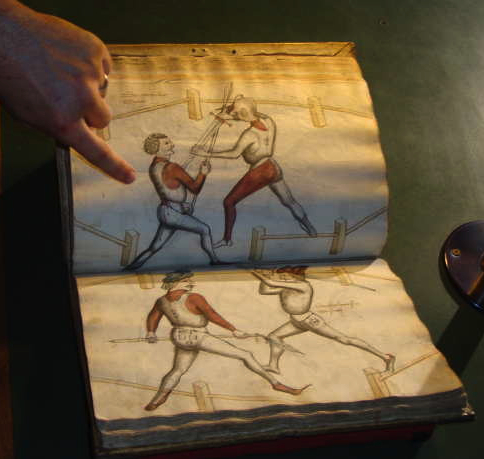 -
None of my prior encounters with original fight-books prepared me for
Talhoffer's original. I was thrilled at its detail, its color and
vibrancy. I was shocked to learn it was made on paper (!)The condition
of the work was excellent for being well over 500 years old.
The pages looked literally like they might have been made yesterday. I
fought to contain how excited I was as I finally sat down to look at it
closely. My fingers trembled as I ever so carefully turned the pages on
camera. Even in the coolness of the library I could feel the sweat forming
on my palms. I had to concentrate to keep my breathing even and my fingers
from shaking as I examined the sections, turning pages at the director's
cue. It actually started to become a bit stressful as each page
was slightly stuck together and required exquisite sensitivity to touch
and then turn yet maintain complete decorum for the camera – Lol!
There was the director telling me, "turn… turn… turn…"
and there I was thinking, "There's no freaking way I am going to turn
this incredible historical work any faster than I am now just to get a
shot for TV! The pages are sticking!" But I was determined to be
careful and mindful of the item – of which I was informed less
than 50 people have been documented as having handled it in the last 200
years! I looked up ever so briefly more than once to catch
sight of the two curators nervously staring at me with baited breath.
Fortunately, they soon gave a visible sigh of relief as they saw how cautious
and delicate I was being with it. Later they actually thanked me for being
so overtly considerate.
-
None of my prior encounters with original fight-books prepared me for
Talhoffer's original. I was thrilled at its detail, its color and
vibrancy. I was shocked to learn it was made on paper (!)The condition
of the work was excellent for being well over 500 years old.
The pages looked literally like they might have been made yesterday. I
fought to contain how excited I was as I finally sat down to look at it
closely. My fingers trembled as I ever so carefully turned the pages on
camera. Even in the coolness of the library I could feel the sweat forming
on my palms. I had to concentrate to keep my breathing even and my fingers
from shaking as I examined the sections, turning pages at the director's
cue. It actually started to become a bit stressful as each page
was slightly stuck together and required exquisite sensitivity to touch
and then turn yet maintain complete decorum for the camera – Lol!
There was the director telling me, "turn… turn… turn…"
and there I was thinking, "There's no freaking way I am going to turn
this incredible historical work any faster than I am now just to get a
shot for TV! The pages are sticking!" But I was determined to be
careful and mindful of the item – of which I was informed less
than 50 people have been documented as having handled it in the last 200
years! I looked up ever so briefly more than once to catch
sight of the two curators nervously staring at me with baited breath.
Fortunately, they soon gave a visible sigh of relief as they saw how cautious
and delicate I was being with it. Later they actually thanked me for being
so overtly considerate.
- What
was frustrating for me was how briefly the whole thing passed. Although
it took some 90 minutes or so to film, it felt like 15 minutes.
I hardly got to look at the extraordinary detail of each illustration
and my mind was racing to memorize all the little subtleties that were
evident because of the texture of the illustrator's brush or the way the
light caught the grain of the page or the manner in which the contrasting
colors gave off some hitherto unnoticeable element. Still, I gained some
insight into some of the key images that have long intrigued or puzzled
me. I did manage to flip through every page of the foot combat section
twice — but not at the pace I would have enjoyed and not with Aaron
beside me to analysis and discuss finer points the way we would have preferred.
Unfortunately, viewing the rest of the work was more of the hurry up and
"act" for the camera. In that regard it was disappointing. But overall
the experience was nothing short of thrilling.
Shortly afterward we were looking at a copy of Talhoffer on my iphone
and just shaking our heads at how much of the beauty of the work was lost
in flat photos. Even the most high-resolution digital edition pales in
comparison to how gorgeous the original was and how much detail could
be seen on every figure.
Fighting by Faking vs. Fake Fighting
"You can't fake 'it' unless you actually know 'it.'"
- The majority of the scenes were done with a Hasty cam but several of our fight sequences Wild Dream used a special state-of-the-art $90k RED Epic 5k digital cinema camera (!) for super high-speed slo-mo results that were nothing short of astonishing. Ted RED cam is so sensitive it literally captures on frame the dust in the air that the human eye can't normally see. At the end of the final day our director said he was totally pleased, saying he was confident he had gotten something never captured before. Pretty cool. I especially hope the intense messer fight Aaron and I conducted in the forest appears in the final edit at enough length to justify the energy we put into it. We really went all out on that.
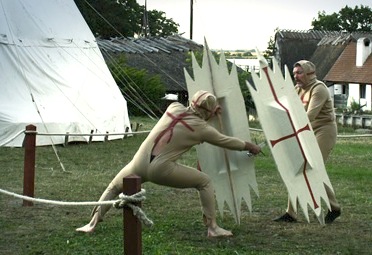 -
What we feel we brought to the Medieval
Fight Book combat scenes was something unique. The typical film
fight is the art of faking it.
But none of the directors or performers really know what the "it" is that
they're faking. They haven't reconstructed "it" well enough to be able
to fake "it" well enough. Their craft is a performance art not a martial
art. It's about prolonging the fight not shortening it. It invariably
relies on exaggerating and telegraphing moves for safety and theatricality.
For us, however, as martial artists of Medieval and Renaissance European
methods, our craft is completely the opposite. We conceal our true intentions
while reading the opponent's. Though each discipline uses the same
tools and even the same sources of inspiration and neither intends real
harm when practicing, they are still entirely opposite in motive, mentality,
and goal. So, in order to avoid danger at all costs the standard
approach to stunt-fight arrangement is to take the violence out of any
depiction of violence because they know no other way. It then becomes
operatic, an armed ballet routine. For us, since constantly training
safely in real fighting arts with real weapons using a wealth of real
techniques is what we do, we are able to draw on a far greater sense of
action using a more dynamic sense of timing and range. We can then
provide a very different experience for the director's vision of offering
something new to viewers. The simple fact of the matter is: "It's
far easier for a real fighter to pretend to fight than it is for a pretend
fighter to appear to fight for real."
-
What we feel we brought to the Medieval
Fight Book combat scenes was something unique. The typical film
fight is the art of faking it.
But none of the directors or performers really know what the "it" is that
they're faking. They haven't reconstructed "it" well enough to be able
to fake "it" well enough. Their craft is a performance art not a martial
art. It's about prolonging the fight not shortening it. It invariably
relies on exaggerating and telegraphing moves for safety and theatricality.
For us, however, as martial artists of Medieval and Renaissance European
methods, our craft is completely the opposite. We conceal our true intentions
while reading the opponent's. Though each discipline uses the same
tools and even the same sources of inspiration and neither intends real
harm when practicing, they are still entirely opposite in motive, mentality,
and goal. So, in order to avoid danger at all costs the standard
approach to stunt-fight arrangement is to take the violence out of any
depiction of violence because they know no other way. It then becomes
operatic, an armed ballet routine. For us, since constantly training
safely in real fighting arts with real weapons using a wealth of real
techniques is what we do, we are able to draw on a far greater sense of
action using a more dynamic sense of timing and range. We can then
provide a very different experience for the director's vision of offering
something new to viewers. The simple fact of the matter is: "It's
far easier for a real fighter to pretend to fight than it is for a pretend
fighter to appear to fight for real."
- Thus,
what we don't do is train to mimic some movement sequences. Rather, we
derive spontaneous actions from the key principles of fighting and the
environment (both physical and dramatic). We apply leverage and utilize
space realistically to achieve a very different appearance than achieved
with standard Hollywood fight-choreography theory. This is not to
be critical of stage combat / theatrical fencing in and of itself, but
rather to contrast it with a love of the authentic art of genuine historical
combat. Performance fighting for entertainment is always a compromise
of violent reality with need for safety and dramatic necessity. But the
sophistication of the historical craft, the physicality and emotionality
of real personal violence (how human beings and weapons actually perform
and react), is a matter of real physics, real leverage, real speed, real
range, real timing, and real techniques. It is about simplicity of brutal
actions not the silly, insipid, distortions and misrepresentations that
so plague the stunt fencing guilds that dominate the entertainment industry.
- This is the very reason why in the
1970s, Bruce Lee, as a real fighter and expert martial artist, was able
to literally transform fight choreography into something never seen before.
I have been saying for years that the same has yet to happen for historical
Western European fighting styles---which remain trapped in the absurd
clichés of 1930s sport fencers mixed with the operatic nonsense of kung
fu theater. Bruce revolutionized fight choreography because he was
a master at real movements virtually nobody had seen before. And he could
can execute them with precision. So his fight scenes had a spontaneity
and creative energy --- that we don't see today even with all the jerky
camera-tricks and digital effects. Instead, we see the theatrical preparation
and choreography, which to the untrained eye might be entertaining for
awhile but don't reflect much at all of the breath and depth and richness
of the physicality it pretends to portray. It ends up derivative and lacking
the dynamism found in actual violence. This is a reason why
we are now doing something different. ...Whether
or not the editor/directors/powers-that-be recognize enough to show things
at full speed and not turn it into the usual slo-mo, remains to be seen.
- Proud as we are of what we accomplished
on this project, the one thing that we really feel simply did not get
across, that we were just not allowed to express or go into, was how the
basic movements and techniques shown in Talhoffer's fechtbuch —
especially as evidenced in the substantial Ringen and dagger images —
display a sophisticated understanding of a highly effective close-combat
method. That to me is unequivocally the central message of the material
for us today. They Medieval world was a violent, brutal, nasty place
that demanded you have such practical skills. Oh well, that's entertainment.
You never really know until you see what makes the final cut for broadcast.
Misadventure, Inconvenience, and Airline
Frustrations
- I have no intention of ever flying
Delta airlines again. While the flight crews were great and the airport
staff in Denmark very nice, the incompetence of the airline in general
is really unforgivable. We know they can't do a thing about the
inconvenience of the incident that occurred on our incoming flight. But
our bags shouldn't have then missed both our connection and the same day
follow up flights and certainly shouldn't have taken three days to be
delivered to us.
- It only got worse on our return flight.
Despite arriving at the Copenhagen airport five
hours before our flight's departure, and being the very first two
people in line when the counter opened, they displayed an astonishing
ineptitude. They told us that not only had our flight already taken
off but that we were already on it! We had to go back and forth between
three different counters because no one console screen had all the info
they needed to correct their screw up. They took over an hour to
clear up their mistake. But meanwhile we couldn't check our bags in. Then
they next told Aaron that his armor case was now too heavy to be allowed
into the USA – even though it had arrived from the USA on their
airline! Idiots. To make it worse, the case was actually lighter
than it had been because we had already transferred some items to our
other bags. So, it took us another hour of labor in front of their
counter to lighten the case enough for them to finally permit it to be
checked. By then it was so late that we had to run to a whole different
area to check in our bags then run through the airport to make our flight
as the last two passengers to board! All that after arriving 5 hours
early. Then at security we were delayed again when I got pulled out of
line because I had two of those tiny 10-ounce containers of hand cleanser
in my bag -- containers which I had brought with me on the arriving flight
without any incident. They kept us ten minutes while the woman had to
search and search and search to find them instead of simply asking me
where they were. Ugggh.
- If we had gotten to the airport with
the standard two-hours of time we would have certainly missed our flight.
I was pretty pissed because I lost out on some special shopping for my
family that I had planned all week to take care of at the airport.
Plus, as we were waiting in line to move up to our gate along with passengers
for other flights, I asked the ticket collector if I could bring a glass
bottle drink aboard. He said yes. So I stepped out of line and a dozen
or so feet away purchased two delicious pear ciders (unavailable in the
USA) for Aaron and I. Again, I asked the vendor if we were allowed
to bring bottles aboard. Now mind you, at this point we were at our gate,
well behind the security area and only waiting to walk down the boarding
corridor to our plane. But once on board the flight attendants confiscate
my bottles telling me they're forbidden onboard! What total nonsense.
I was pretty damn pissed. Then to add insult to injury, Delta loses
Aaron's armor case on his connecting flight back to Wisconsin! When
it at last turned up days later all his armor was so trashed, being scratched
and bent and deformed, he is convinced some baggage handlers must have
removed it and played around with it somehow. Delta was simply horrible.
They showed absolutely no professional responsibility or concern for how
they repeatedly victimized us and never offered a single apology or consolation
for all their screw-ups.
- John Clements, Dec 2010
*Update After Airing:
After watching the program on its first air date, I have to say it was very, very well done. The graphics were beautiful and the content was well executed. The amount of material concisely covered made for good television. Still, as a student of fighting arts it was somewhat disappointing. It's hard to cover everything in a single 60-minute program. And yet, there is no escaping the fact that the programmed failed to bother informing the viewer of the importance of Talhoffer's manuscript as the first illustrated book on 15th century Germanic fighting skills, or mention at all that numerous other versions of the work were produced as specifically martial art study guides. They focused some 70% of the program on the war-machines and then most of the rest on the woman's judicial duel with far less on the martial arts content, even though these fighting skills make up more than half the book's actual material--which you wouldn't know from watching the program. This is not unsurprising given that it is National Geographic. But, the fact that National Geographic is doing a program on a 15th century Fechtbuch at all is in itself exciting. It was a downer though that our forest messer fight that we spent half the day doing for them was entirely omitted. The action we arranged was unprecedented. It was also disappointing that they left out virtually all the judicial shield fight as well (even though we were very unsatisfied with how the shields performed). It was especially disappointing that they didn't show us fighting at proper speed but instead went yet again with the slow-motion despite us giving them tons of beautiful techniques at full energy and also doing full speed strikes with a sharp blade on armor. It's baffling why they make the choices they do sometimes. But, on the bright side, we were both extremely pleased with how we presented ourselves and how we represented the subject. Our choreography and demos did look pretty good too. This is a good start. In the end though, the definitive program on this material has yet to be done ---and we have yet to get to showcase what we're capable of doing. - JC
Behind the Scenes Video Clips: |
||
|
Excerpts from ARMA
video blog chat of 1st day
|
John encounters communication
difficulties in the 14th century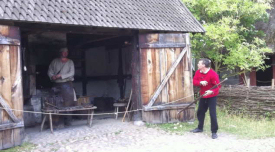 |
|
|
|
||
